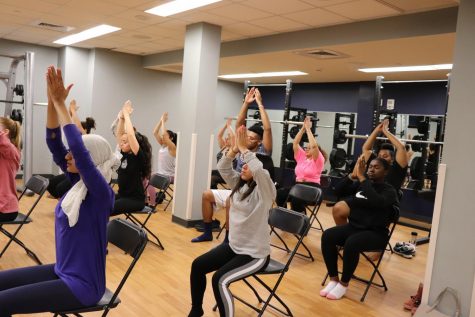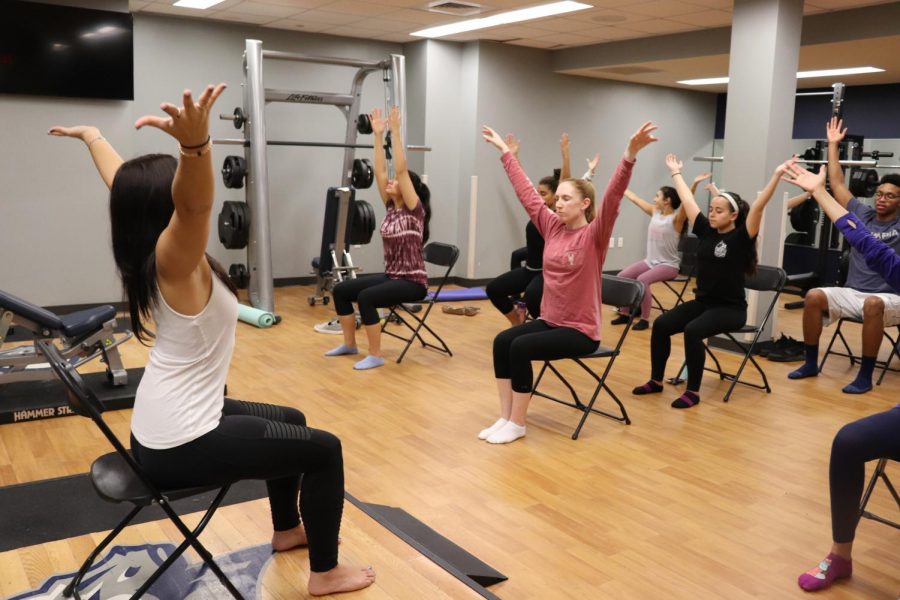Chair Yoga , Yoga for All
Mercy College celebrates Disability month by hosting a Chair Yoga event, yoga that is inclusive to all physical disabilities.
“OK class, think about your commute here today. Did you use the stairs? Was there a ramp? Is there an elevator  nearby? Did the doors automatically open? Are there “curb cuts” available? If you have not noticed these accessible features it’s because you did not have to. Take this moment to show your body graduate. Now raise your hands together and breathe in, sitting in your chairs.”
nearby? Did the doors automatically open? Are there “curb cuts” available? If you have not noticed these accessible features it’s because you did not have to. Take this moment to show your body graduate. Now raise your hands together and breathe in, sitting in your chairs.”
This is how Helen Lipson, yoga instructor at Mercy College, starts the annual Chair Yoga class to honor Disability Awareness month every October.
Chair Yoga is a form of yoga that can be performed by people with physical disabilities, such as a wheelchair. It is a gentler form of yoga that is inclusive, providing the same benefits of yoga such as deep stretching, breathing, meditation and relaxation.
“The spin bends in six different ways which can be exercised perfectly in a chair. You can sit in candle pose and bend forward in child pose. The point is to connect it to your breathing and energy,” Lipson said.
YogaBasics.com says that the art of yoga originated in the east in northern India over 5,000 years ago. Participants had to do a lot of mental challenges before they could even get to the physical aspect of yoga .
“The West ruined yoga by just going into doing all the physically aspects right away. Originally, you couldn’t be a negative person and just head into doing yoga. You had to be in a healthy state of mind. It is not about the physical activity, it is about the mind. One could sit in a chair and breathe, and he or she just did an hour of yoga,” Lipson explains as the class chuckles.
As the class progressed, Lipson concentrated on her students breathing as she directing them to bend forward in there chair, up again, clearing their thoughts of outside noice. The class was silent with, their eyes closed. Their bodies moved like water as they followed her directions.
One could hear a pin drop as the class continued to listen to Lipson, their upper bodies loosened in their chair moving to the rhythm of peace and relaxation.
Chair Yoga is a perfect way to celebrate the diversity in different body types affected by a disability. After all, every mind and body is different, and these differences should be honored.
“Being able to recognize different body types is important. Everyone is working on something different, and you don’t need to force yourself. You should feel equal effort and ease,” she advises the class as she demonstrates a complex lower arm movement.
Half of the class settles with the easier arm movement she showed incase their arms weren’t flexible enough. The whole class breathes as one for the seconds holding the same position.
The organizer of the event, Molly McCabe, is the Director for the Office of Accessibility at Mercy. She was so eager for the students to dive into chair yoga and to not only bring awareness to disability but also celebrate t as a form of diversity.
“The Office of Accessibility helps a total of 450 students with disabilities. We tend to a few students with physical disabilities. However, many are actual what we tend to call invisible disabilities such as learning, vision, hearing and mental health disabilities,” she saids.
They help give students accommodations for their needs on campus with help like closed captions in classes for people with hearing disabilities, extra time on tests and note takers.
“As apart of Disability Awareness Month, and any month, it is important to be aware of your surrounding and see if they are inclusive. For example, is the elevator working? Is there a curve block? Are the class videos with closed captioning?” she said.
The students unwind their spin vertebrae by vertebrae while taking deep breaths while Lipson directs in a mellow voice.
“When you leave today , take notice and be aware of how accessible your environment is. Think about ways to improve so that everyone can have equal access,” she said.
“Namaste. The light shines in me.”








